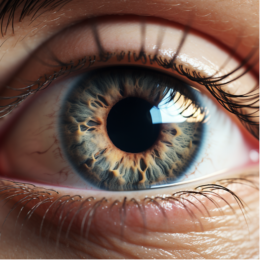Unraveling the Causes of Sudden Vision Loss in One Eye

Vision is one of our most valuable senses, and any sudden change can be alarming. One such alarming change is the sudden loss of vision in one eye, a symptom that requires immediate medical attention. This article explores what causes sudden loss of vision in one eye and provides insights on how to handle and prevent such event.
What Causes Vision Loss in One Eye
Experiencing a sudden loss of vision in one eye can be quite distressing, and more often than not, it indicates serious underlying conditions that warrant immediate medical attention. This segment offers a detailed exploration of the primary culprits behind such a worrying symptom.
Retinal Detachment
Retinal detachment is a severe ocular condition that transpires when the retina – a thin layer of tissue lining the back of the eye – detaches from its normal position. The retina is an integral component of the visual system, converting light rays into nerve signals that the brain interprets as images. Thus, when a detachment occurs, the retina ceases to function correctly, leading to a sudden loss of vision. Without prompt medical intervention, the result could be a permanent loss of vision, underscoring the need for immediate treatment (NIH, 2023).
Vascular Occlusion
Another common instigator of sudden vision loss is vascular occlusion, which refers to a blockage in the blood vessels that supply the eye. This occlusion can lead to two significant conditions: retinal artery occlusion and retinal vein occlusion. Both can cause sudden loss of vision in one eye. Interestingly, these ocular problems often stem from other systemic health issues. For instance, hypertension, or high blood pressure, and diabetes can increase the risk of developing vascular occlusions (American Academy of Ophthalmology, 2023).
Optic Neuritis
This condition is an inflammation of the optic nerve, the crucial pathway transmitting visual information from the retina to the brain. Often linked to autoimmune conditions like multiple sclerosis, optic neuritis can cause significant discomfort, including pain and vision loss, typically affecting one eye. The vision loss can be sudden, making it another important cause to consider when evaluating sudden vision loss (Mayo Clinic, 2023).

Stroke
A stroke, or cerebral vascular accident, involves a sudden interruption in the brain’s blood supply. When a stroke affects the visual pathways in the brain, it may lead to sudden vision loss in one eye. It is essential to understand that a stroke is a medical emergency and can present other symptoms beyond vision loss, such as sudden confusion, trouble speaking, or severe headache (American Stroke Association, 2023).
Facts and Statistics About Sudden Vision Loss
Fascinating and sometimes startling statistics shed light on the prevalence and impact of sudden vision loss:
The prevalence of vision loss: According to a recent study by the World Health Organization (2023), approximately 2.2 billion people worldwide have a vision impairment, and over 1 million people experience sudden vision loss annually.
Link with Age: Age is a significant risk factor for sudden vision loss. A report by the American Academy of Ophthalmology (2023) suggests that individuals over 60 years old have a 30% higher risk of experiencing this issue compared to younger age groups.
Gender disparity: Interestingly, men are more prone to certain types of sudden vision loss such as retinal detachment, with 60% more cases reported than in women (American Academy of Ophthalmology, 2023).
Prevention and Management
Preventing sudden vision loss may not always be possible, but recognizing the risk factors and managing them effectively can significantly reduce the likelihood of this distressing occurrence.
Regular eye exams
Regular eye examinations can help identify potential issues early, including those that can cause loss of vision. The American Optometric Association recommends adults have a comprehensive eye exam every two years, or annually for those over 60.
Management of systemic diseases
Controlling systemic conditions like diabetes and hypertension is crucial in preventing vascular occlusions that can lead to vision loss (American Diabetes Association, 2023).
Prompt medical attention
How to stop vision loss? Recognizing the symptoms and seeking immediate medical attention can help prevent permanent damage. Symptoms can include sudden vision loss, flashes of light, or a sudden increase in floaters.
Conclusion
Understanding what causes sudden loss of vision in one eye is the first step to preventing and managing this potentially debilitating condition. Regular eye examinations, managing systemic diseases, and immediate response to symptoms are crucial in this regard. This information, coupled with awareness and right action, can help preserve our valuable sense of sight. It is always important to consult with healthcare professionals or eye care specialists when you experience any changes in your vision.
References:
- NIH (2022). Retinal Detachment. National Eye Institute. Retrieved from https://www.nei.nih.gov/learn-about-eye-health/eye-conditions-and-diseases/retinal-detachment
- American Academy of Ophthalmology (2023). Eye Health Statistics. Retrieved from https://www.aao.org/newsroom/eye-health-statistics
- Mayo Clinic (2023). Optic neuritis. Retrieved from https://www.mayoclinic.org/diseases-conditions/optic-neuritis/symptoms-causes/syc-20354953
- American Stroke Association (2023). Visual Disturbances and Stroke. Retrieved from https://www.stroke.org/en/about-stroke/effects-of-stroke/physical-effects-of-stroke/physical-impact/visual-disturbances
- World Health Organization (2019). World report on vision. Retrieved from https://www.who.int/publications/i/item/9789241516570
- American Optometric Association (2023). Recommended Eye Exam Frequency. Retrieved from https://www.aoa.org/healthy-eyes/caring-for-your-eyes/eye-exams?sso=y
- American Diabetes Association (2023). Eye Complications. Retrieved from https://diabetes.org/diabetes/complications/eye-complications


